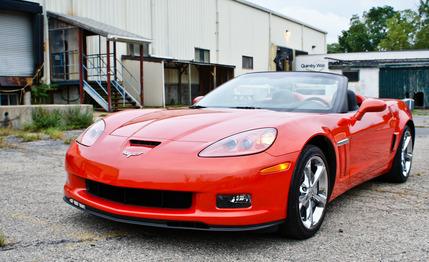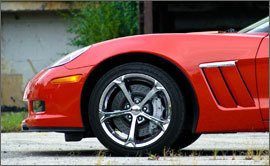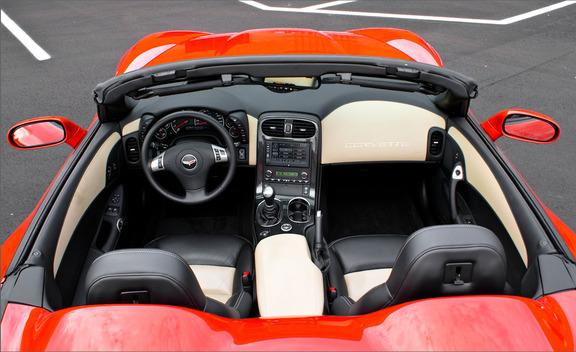 Short Take Road Test
Short Take Road Test
Currently in its sixth generation as America’s sports car, the Chevrolet Corvette bristles with track-bred performance, unmistakable design, and everyday comforts. Although it hasn’t been entirely modernized—leaf springs, anyone?—General Motors has whittled away at the car’s rough edges for well over half a century, and the result is one of the best all-around performance cars for the money.
The revival of the Grand Sport name for 2010 bridged the chasm between the $50,000 base car and the increasingly expensive Z06, which now starts at $75,255. In brief, the GS brings the Z06’s sharper suspension and brakes—as well as its flared bodywork—down to the base Vette. The convertible GS is the most potent droptop Corvette. For 2011, what might appear to be small news—the availability of a new optional suspension package—is in reality very significant.

Topless Rocket
Blessed with a stiff structure that differs little from the coupe’s, our 3381-pound test car was only four pounds heavier than the last GS hardtop we tested. And with no roof to muffle the roar from the optional exhaust’s vacuum-actuated bypass valves, the GS convertible was a riot between stoplights on Detroit’s fabled Woodward Avenue during the Dream Cruise. Power comes from the standard Corvette’s 6.2-liter LS3 V-8, which develops 436 hp and 428 lb-ft of torque with the trick exhaust (or 430 hp and 424 lb-ft without).
Straight-line acceleration is relentless and on par with that of other 6.2-liter Corvettes we’ve tested: 0 to 60 mph in 4.2 seconds and the quarter-mile in 12.6 at 115 mph. The convertible has an estimated coupe-matching top speed of 185 mph.
Grip and Grins
The Grand Sport is visually distinguished from the standard Corvette by the Z06’s wider (by 3.3 inches) bodywork, along with unique fender vents and wheels (18-inchers up front, 19s at the rear). The borrowed Z06 brakes are good for a stellar 150-foot stop from 70 to 0 mph in this car, and they offer solid pedal feel and good modulation.
The biggest news for 2011, however, is the optional F55 Magnetic Selective Ride Control package ($1695), which bundles two-mode magnetorheological shocks with massive, second-generation Goodyear F1 Supercar run-flat tires. As equipped, this car fused to the skidpad for an incredible 1.06 g, with a far more progressive breakaway than before when exceeding its limits. For comparison, 1.02 g is the best we recorded for a 2010 Grand Sport coupe.
We still prefer the new Michelin Pilot Sport 2s that are optional on the Z06 for 2011—they’re even more predictable—but the updated Goodyears hugely improve overall drivability at the limit, allowing the GS to essentially match the 1.07 g posted by the Z06 and ZR1.
You Could Drive It Regularly…
Although most of the Grand Sport’s lofty performance can’t be truly realized anywhere but on a racetrack—an environment where the steering in Corvettes seems to come alive and all the power can be utilized—the GS convertible is easy to drive and more than capable for day-to-day running. The convertible lacks the coupe’s 22-cubic-foot hatch, but 11 cubes (7.5 with the top down) remain in the trunk for groceries or luggage.
With the suspension in the softer touring mode, the ride is fairly compliant, and road tremors through the steering column and cowl are minimal; the sport setting is best left for the kind of super-smooth stretches of asphalt that don’t exist in Michigan. Although all Vettes except the ZR1 avoid a gas-guzzler tax (ours was rated for 16 mpg city and 26 mpg highway), the floor-it-and-sit nature of the Woodward Dream Cruise reduced our overall average to 15 mpg.
…but Would You Want To with This One?
Using this particular car as a daily driver brought its own set of issues, the first of which we noticed as soon as the car pulled up to our office. The new-for-2011 Inferno Orange Metallic paint, combined with the bling from the chrome wheels and the off-putting beige softtop, made it look as if an inspired Pimp My Ride viewer—or maybe just a pimp—had special-ordered the car, only to give it back to GM when he realized he didn’t have enough gold teeth to pull off driving it. The car looked much cleaner with the top down, and that’s how we left it.


This Grand Sport’s low-rent interior was another sore spot, particularly the lumpy, unsupportive seats that felt as if they were padded with loaves of bread. Hitting 1.06 g in a very fast, open-top car with no dedicated rollover protection and chintzy seats is more terrifying than exhilarating. The seats are a disgrace in a car of this caliber, and their continued use after years of criticism makes us wonder if GM is being blackmailed into keeping the supply contract alive.
Misguided Options
At its base price of $59,550—a $3810 premium over the coupe—the Corvette Grand Sport convertible hits all our requirements for a hot summer ride: speed, style, and open to the wind of the road. But stir in the top-level, $9700 4LT group—leather-wrapped interior, premium Bose sound system, satellite radio, head-up display, power telescoping steering wheel, heated and powered seats, Bluetooth, and power top—as well as the $1995 F55 adjustable suspension, $1195 upgraded exhaust, $1995 chrome wheels, $1795 navigation, and $300 Inferno Orange paint, and you arrive at the very dear as-tested $76,530 sticker.
For our money, we’d opt for one of the lesser levels of LT trim and spend the difference on a pair of aftermarket seats. Or maybe we’d go for the less-expensive—and more comfortably exploitable—GS coupe and get our open-air kicks from its standard removable roof panel.